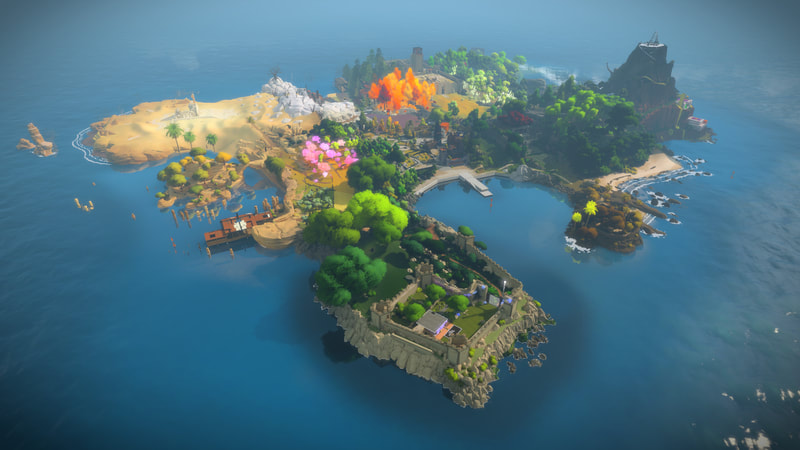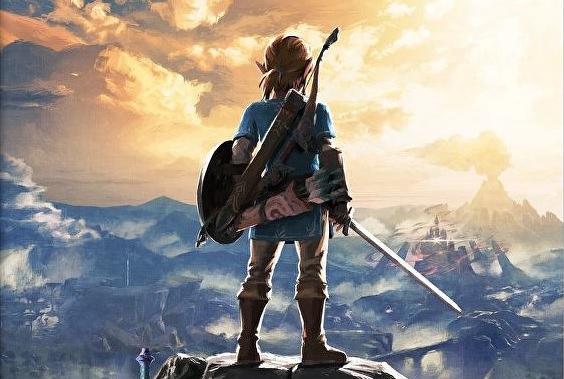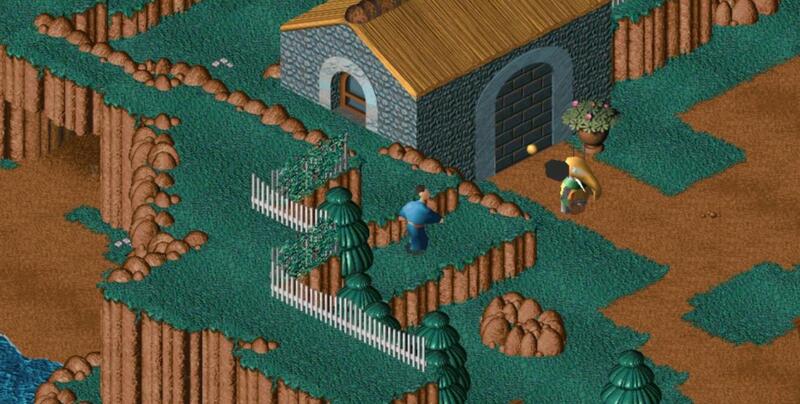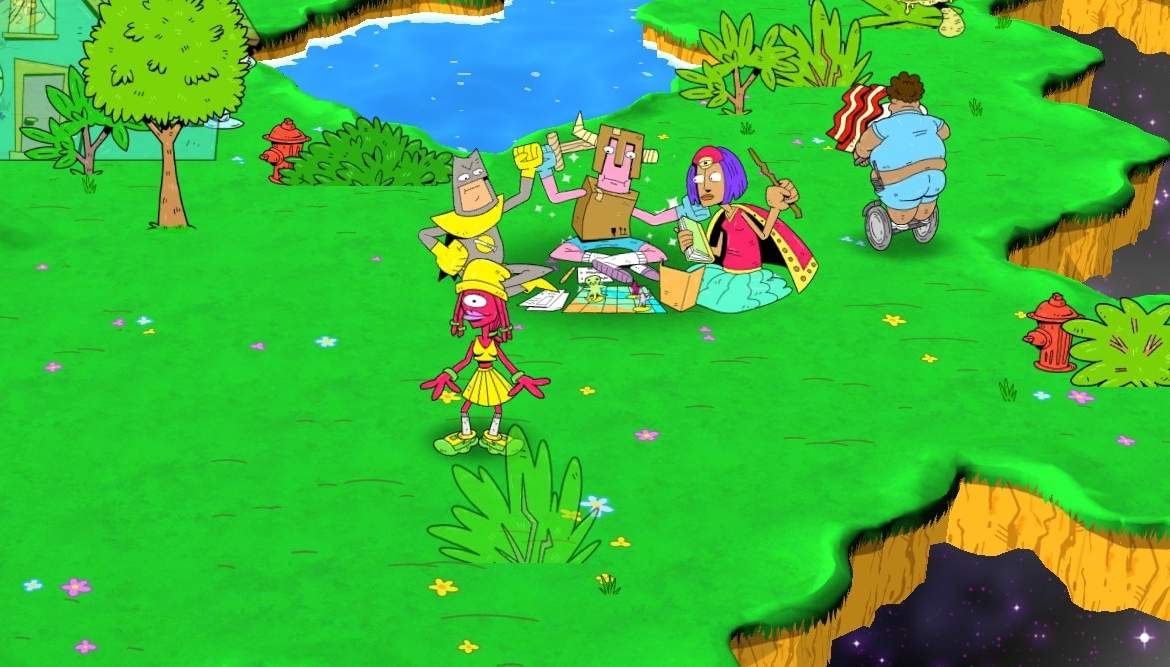|
So today I’m looking at games that are inspirations for me as a developer. But these are special cases, not necessarily inspirations in the sense of having an emotional or mental significance for me (although often that too), but in the sense that my mind has filed them away as lets say “game designer toolbox” games: which is to say each of them represents a particular concept or set of concepts or mechanics that my subconscious bubbles up to me again and again when I’m designing games.
But “game designer toolbox” sounds very dry, so I’m calling them Pandora’s box games, since they also contain the tantalizing risk of over-scoping due to the scale or potential of their ideas. The Witness I suppose it’s not uncommon for designers have one or a few games that they catch themselves referencing a little too much. For me that’s The Witness. From the first screenshot I ever saw of it, years before it was released, I knew it was something special, even though I didn’t have a clue what the actual gameplay was at that point. My next clue was an early preview/interview video where Jon Blow played through the first 10mins or so with an interviewer and introduced a lot of the gameplay concepts. In that video he said something like “instead of players collecting items in the game, they explore it to collect concepts in their own mind”. A lofty ambition, but after playing the game who could really say it's not executed exceptionally well. While you could say that mastering many games out there is like learning a new language, The Witness is one of very few games where this is literally true – all around the game world are symbols whose meaning we learn (but being symbols whose meanings are rules rather than words, their “meanings” are paradoxically more abstract and more concrete than verbal meanings), and these symbols are connected to places, both as a strong game design memory-flag for the player (“remember this symbol that you learned in this area”), but also could be read as an allegory for how language evolves out of its surroundings. So what does this all mean to me? I guess the “players collecting concepts in their own mind” is something I love, and yet my own practice has naturally drawn me away from. Even from my very first game I tried to have minimal UI, no inventory, etc, but being true to myself that just didn’t suit the kind of games I needed to make. Nonetheless, I hold this principle of Jon Blow’s in high regard, even if it serves as a counterpoint to my own practice, that’s still an invaluable thing to have. Inside a Star Filled Sky (ISFS) Doesn’t that name in itself just take you on a journey? As soon as I heard it I knew this game was for me. It came out a year after the Inception, and I’d be curious to know whether its “worlds within worlds” design was inspired by that film. Whether it was or not, ISFS is clearly happy doing its own thing. Not only can you go inside worlds inside worlds, but you can go inside enemies, where their insides are a level and you can change their attributes by how you play that level, and you can go inside powerups and change their attributes, and all of this is infinitely recursive – so you can go inside a thing inside a thing inside a thing, to infinity! Now apart from that, what’s the game about? Yeah, well not much else unfortunately, you just use this brilliant recursive structure to shoot things and get to the highest level you can. So that’s not what is interesting to me. Beyond the recursive stuff, which I could explore forever as a game designer, if I had any idea how to make it, there is one shining jewel from this game that has set itself in my mind and stayed there for over 10 years now… …but it’s not easy to communicate. Maybe I can summarise it like this: I’m in a level, pinned down by an enemy that I clearly can’t get past in my current state, so I go inside the enemy to try to weaken it. While inside, I find a particular type of powerup that would fix my problem out there, but it’s not powerful enough, so I go inside it to power it up, there I have to play through a few stages to get it to the level of power I need. So then I return back up through those levels, out of the power up which I now collect, then out of the enemy which I can now get past. This has all taken say 10-15 minutes. But the jewel of my personal experience was, when I returned to the enemy-situation that had caused me to go on that tangent, I remembered why I had gone on that tangent. As in, only then did I remember. Up until then I was in another world, I had a different purpose. Hmm, I don’t know if this will make sense, but it was a powerful sensation. Imagine if you emerged from this life you’re living now, your whole life from birth to death, and it turns out it was just a small piece, a side mission, of a bigger life that contained many such lives. It was like a little flash of that. Enough said I think! So it happens from time to time when I’m working on something that, in my game design document I’ll reference the “Star Filled Sky Experience”. Gunpoint I’m tempted to just say nothing else except CROSSLINK: that’s the aspect of this game that I just love and think about often. Looking at something like hacking in the Watchdogs series, it’s easy to see how a similar concept can easily be diluted. But Gunpoint does it so perfectly, aided I’m sure by the fact that the game is so minimal, so there are few distractions in the way of getting this mechanic just right, and communicating it to players so clearly. Aside from its specific implementation in the game (ie interconnecting electrical devices) which in itself has a world of possibilities for a game designer to explore further, the concept of interdependent connections, and the resulting emergent problem solving this can offer players, could be applied to any other context you could imagine (magic systems, social systems, character behaviours, etc, etc), and has such huge untapped potential. Breath of the Wild (BotW) After Majora’s Mask I hadn’t played any Zelda games for a long time before BotW. For several reasons I basically stopped playing any game that had any kind of combat in it (I’m just over it, on so many levels). But when I saw the BotW team’s GDC talk, and specifically the stuff about what they called the “chemistry engine” I was absolutely sold on this game. In fact after simply watching that talk, and before I’d ever even played the game, I started designing a new game based on that chemistry engine principle. After a while this idea has just become second nature, so unlike say Star Filled Sky, I don’t often reference BotW in my game design docs, but that’s really the genius of the chemistry engine, it’s low hanging fruit, it’s so obvious and “real world” that once you have it in your game design toolkit you don’t really need to consciously think about it, it’s just there to use as you need it. For me the second piece of the puzzle of this becoming second nature was my experience with Mario Maker 2. Mario Maker 2 This is just a short one because, through my game designer’s lens Mario Maker is less a game than a fun game design tool. In a nutshell, my revelation moment was seeing each component of the Mario games – keys, springboards, timer-switches, pipes that spawn objects, etc, etc – and seeing them presented in this clear and simple UI. It was like half the work was done for me already, so I started prototyping a lot of this functionality, not for a specific game, but just as a foundation of components that I could use for any game I was working on. Then not long into this process, the chemistry engine stuff started to get included. I ended up leaving this prototype behind, but on a later game project, without even thinking about it, I started to implement this way of thinking (which could be called an entity component system, but I think that term is way too broad to really mean much) and eventually fully realised this robust system of modular behaviours including those Mario Maker and chemistry engine inspired aspects, and much more beyond. Risk/Rewards of Hidden and Secret Information – Cinco Paus and Toe Jam and Earl: Back in the Groove Sure there are tons of games that skilfully explore “risk/rewards of hidden and secret information”, it just happens that for me these are the two the crystallised in my mind why this concept matters. And I love that these are such different games from each other, but when I’m writing game design docs my subconscious will often say “the game should do etc etc using hidden information like Cinco/Toe Jam”. I think this amalgamation works for me because there is such a polar difference between how these games use hidden information and what’s at stake: in turn-based Cinco, every move matters, the board is small, danger is always close, every risk has a high probability of failure. But in Toe Jam and Earl, you can kind of do whatever and just bumble your way through, if one present (the game’s hidden information “currency”) doesn’t give you a boon you need, there’s probably five others close at hand that will. While Cinco’s learning experience for me was a slow unfolding (i.e. how could this much density really be packed into this little experience?), with Toe Jam it happened in an instant: I opened a present to get a pair of rocket-skates (“this will help me speed out of trouble”) then immediately skated off the edge of the level. It was hilarious and unexpected, and the happy shock of that made me immediately understand, at an experiential level, the power of risk and reward in hidden information. Relentless (aka Little Big Adventure) I got this game one Christmas, probably in my early teens, and it was one of those times when you feel understood, as in “this game gets me”. While I was too young to understand some of the themes going on, I just felt its resonance and loved it. Looking back on it later in life I appreciated more how well it pulled off this edgy theme of “Twinsen, a descendent of a line of magicians is imprisoned in an insane asylum by a cruel dictator for having prophetic dreams about the end of the world. These dreams are telepathically communicated to Twinsen from a celestial creature in the centre of the planet” which all really contrasts with its lighthearted, playful fantasy-like appearance. The very first thing you have to do in the game is escape this asylum, find your way home and discover and claim your magician lineage hidden in a secret room in your home. Great background but that’s more story stuff, so in regards to this article what matters to me is the players ability to select “character states” which is at the core the gameplay. You can choose between normal, stealthy, athletic or aggressive modes. Maybe it doesn’t seem like a big deal, maybe it’s just an old way of thinking and now if we want to go into different character-modes we can just hold down a button. Yes, that’s definitely true. But as a child I interpreted and remembered these modes as “emotional states” like you could switch from one emotion to another, and that determined what your character could do. Which, if you think about it that way, hopefully you can see what a vast and under-explored possibility space that is! So that’s my lucky seven Pandora’s box games. So many more I’d love to talk about, but I cut the rest from the list as they were really just honourable mentions and not games that genuinely came up in my day to day practice (ok maybe also Future Unfolding for its entirely nature-based puzzle system). Thanks for reading. Feel free to say hi in the comments and sign up to Lamplight Forest for updates on our games
0 Comments
Leave a Reply. |





 RSS Feed
RSS Feed